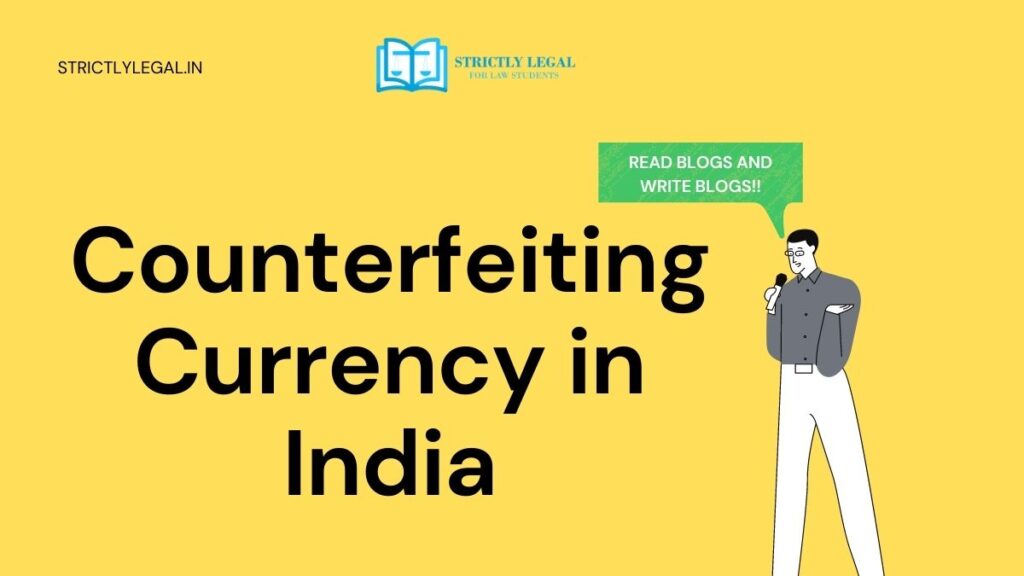Counterfeit currency or counterfeit money is fake currency notes and coins, not issued by the Reserve Bank of India but is a deliberate attempt to circulate notes that imitate the real one to deceive people and avail goods and services in exchange with notes that cannot be used. Producing, circulating, or even using counterfeit money/currency is illegal under multiple provisions of the Indian Penal Code 1860, as we will discuss in this article. Recently more and more counterfeit money is being circulated in the country which is in turn is harming the nation’s economy.
This blog was submitted by Ishan Roy Chowdhury and Darsh Bansal from Amity Law School Delhi
Due to the rise in counterfeiting, the Reserve Bank of India had issued a circular to all banks on how to identify fake currency notes and coins and procedure to employ in cases of detection of such counterfeit currency. The circular also details on the procedure to deal with the person who tenders such counterfeit currency to the bank. The circular and its directions are explained later in this article.
The situation is so bad that the National Crime Records Bureau, a government agency responsible for collecting and analyzing crime data, publishes annual reports detailing detection and investigation of specific counterfeit articles, fake currency compilation system links along with explaining the situation.
Some of the adverse affects that circulation of counterfeit money has on the society and the economy include but are not limited to:
- Increase in money supply without the actual need or reason for it
- Decrease the acceptance of physical cash
- Decrease the value of the actual currency
Due to the above mentioned reasons, it becomes imperative to take regressive actions to safeguard the nation’s economy and put an end to the counterfeiting racket.
Table of Contents
APPLICABLE LAWS FOR COUNTERFEIT CURRENCY:
Multitude of laws are applicable when it comes to counterfeiting currency as it is not just a crime against an individual holder but an act of terrorism against the sovereign state and its people.
The Chapter XII of the Indian Penal Code “Of Offences relating to coin and Government stamps” strictly prohibits and provides punishment for a multitude of counterfeits relating to coins. The chapter defines “coin” and “Indian coin” under section 230 as a metal stamped and issued by the authority of [Government of India] some state or sovereign power in order to be used as money. It details what is counterfeiting of Indian coins and how minting, selling, or even importing of such a fake coin is punishable, ranging from up to 3 years of imprisonment for importing to imprisonment of life which may extend to 10 years for counterfeiting an Indian Coin under Sections 232-235. Delivery of such coins with the knowledge that the coins are fake is punishable under Sections 239 and 240. Abetment of counterfeiting the Indian coins is also punishable in the same manner under section 236.
The Chapter also details how its an offence if a coin making instrument is taken from the coin making (minting) facility (under Section 245) and even the altering or diminishing the weight and composition of the Indian coins and/or changing its looks is an offence (under Section 246-249). The possession of a fake coin with the knowledge of its nature is an offence under section 252 and 253 punishable for an imprisonment up to 3 years for a foreign coin and for an imprisonment up to 5 years for an Indian counterfeit coin.
Certain provisions of the Indian Penal Code deals with counterfeiting of bank notes/currency notes only, these sections are Sections 489A-489E. These sections collectively explain what counterfeiting currency notes or banknote is and its punishment along with how using such notes (Section 489A) and trying to pass it off as genuine is a crime (Section 489B). Even the possession of such fake notes is considered a crime under Section 489C. Section 489D talks about how making or even possessing an instrument(s) to make fake notes is forgery or counterfeiting of currency notes and is a crime. Even making or using documents that resembles currency notes or bank notes is a crime (under Section 489E).
The Unlawful Activities (Prevention) Act, 1967 has multiple sections relating to counterfeiting currency. “Terrorist act” is defined under Section 15 of the Act. The damage to the monetary stability by production, smuggling or circulating of counterfeit Indian currency is also defined under Terrorist act. Section 17 and 40 states that raising funds for terrorist acts includes raising funds through collection, production, circulation and smuggling of counterfeit Indian currency along with its punishments. The seizure of such counterfeit currency is given under Section 33 of the Act.
THE RBI CIRCULAR TO ALL BANKS:
The Reserve Bank of India acts as the sole regulator and primary body to issue and circulate currency notes in the Indian economy, stipulate security measures for detection and impounding fake currency notes and provisions for appropriate penalties against the defaulting parties.
In its master circular, “Detection and Impounding of Counterfeit Notes” dated 01-04-2021, the Reserve Bank of India issued updated guidelines, compiling instructions of the RBI on the above subject in a comprehensive manner.
The circular imposes an obligations on all banks and treasuries to take up all necessary safeguards and control measures to verify the authenticity of all currency notes, tendered over counter or through chest or before dispensation through ATM machines. It is upon the banks to align their cash management systems in a manner, appropriate enough to secure the flow of money within the banking system by appropriating all bank branches and back offices with equipments like ultra violet lamps, various banknote sorting and detection machines.
Bodies authorized to impound counterfeit money are all banks, treasuries, sub-treasuries and issue offices of RBI. All banks to establish at its head office, a Forged Note Vigilance (FNV) Cell to disseminate instructions of RBI to all bank branches, monitoring its implementation, conducting periodic checks of measures employed and compilation and submission of data and periodic reports to the RBI, FIU-IND and NCRB. The banks shall also designate a Nodal Bank Officer, district wise to serve as a contact point for all counterfeit note related activities between the bank and the police authorities.
All notes determined as counterfeit shall be stamped and impounded in a manner as provided under the circular. All banks are to issue an acknowledgment receipt to the tenderer after stamping and authenticating as provided. The tenderer’s account shall not be credited for any counterfeit detected and impounded by the bank. In no case, the counterfeit detected shall be returned or destroyed by the bank branches or the treasuries. Failure to impound fake currency notes detected by the bank shall be construed as wilful involvement of the bank in circulation of counterfeit currency and penalty may be imposed.
For cases of detection of Counterfeit Notes up to 4 pieces in a single transaction, a consolidated report in the prescribed format should be sent by the Nodal Bank Officer to the police authorities along with the impounded Counterfeit Notes at the end of the month and in cases of detection of Counterfeit Notes of 5 or more pieces, the Counterfeit Notes should be forwarded immediately by the Nodal Bank Officer to the local police authorities for investigation by filing FIR in the prescribed format.
With a view to educate the branch personnel’s on detection of Counterfeit Notes, the banks are mandated to ensure that all bank employees handling cash are trained on features of genuine Indian bank notes. These trainings should cover detection, impounding and reporting of Counterfeit Notes. Details of security features of the New Design banknotes of ₹2000, ₹500, ₹200, ₹100, ₹50, ₹20 and ₹10 are available at their website.
CONCLUSION:
A mere perusal of the above-mentioned points indicates that the Government of India has on time-to-time taken measures to counter the alarming attack on the Indian monetary system. If a counterfeit or faked note is circulated and remains undetected, it becomes a part of the monetary system. It raises prices by the percentage that the value of the counterfeit note bears to the total stock of money in the economy. Today, a large number of counterfeit notes are in circulation and have entered the monetary system, posing great threat to our economy.
The Indian Government took a bold step through its flagship demonetization policy in the year 2016 striking at the raging counterfeiting by revoking the legal sanction behind 500 & 1000 Rupee notes. Given its shortcomings, the demonetization was able to seize substantial sums of fake notes for a while but the new, more secure notes were replicated even faster than ever. Despite the hard steps, the crime still happens, sometimes due to negligence and sometimes for lack of effective enforcing agency. So we can conclude that though counterfeiting still happens the Government can take stricter approach when it comes to offenders like increasing the punishments and setting-up an active body to deal with counterfeiting only.

Users not registered with Strictlylegal can Email us their content and the same are posted through this account. In case of abuse, kindly let us know at [email protected]




